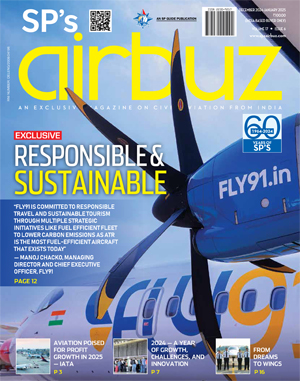LCCs Going Beyond Boundaries
The footprint of low-cost carriers is fast expanding, particularly in Asia, driven by economic upsurge in most nations.

Mention low-cost carriers (LCCs) and the names of Richard Branson and Tony Fernandes and of course of Captain G.R. Gopinath in India figure prominently in the who’s who of aviation. These pioneers have been iconic, visionary and above all daring to chart untreaded paths and emerging victorious. Thanks to these leaders, the aviation scene has dramatically changed over the years and LCCs are set to rule.
Low-Cost Carriers Gaining Ground
Why so? If we go by the tagline of Tony Fernandes’s AirAsia ‘Now everyone can fly’, that truly is a game-changer bringing in inclusivity. It is for that simple reason that the LCC footprint is fast expanding, particularly in Asia, driven by economic upsurge in most nations. According to the Centre for Asia Pacific Aviation (CAPA), LCCs in the Asia-Pacific region operate a combined fleet of nearly 1,000 aircraft and there are over 1,500 aircraft orders in place. This year another 10 LCCs are expected to take-off, taking the total number of LCCs in Asia-Pacific to nearly 60.
Presently, LCCs account for only 15 per cent of the region’s fleet and slightly over 20 per cent of seat capacity but approximately 50 per cent of orders. Ten years ago LCCs accounted for only two per cent of total capacity in Asia-Pacific which clearly indicates how they are growing. Yes, they could still be way behind the 42-yearold Southwest Airline which has a fleet of about 700 and Branson’s Ryanair and EasyJet put together have about 500 aircraft.
The fact that the LCCs are not only catering to the domestic market but also going international reflects the attractiveness of this segment to a majority of the population. AirAsia is a classic example of the strides it has made, if not global, but of the region and beyond. The AirAsia group (Air Asia, Malaysia; AirAsia X, AirAsia Indonesia and AirAsia Philippines) is the largest LCC group in Asia with an inservice fleet of 172 aircraft. Once Thai AirAsia X and AirAsia India, a joint venture with the Tata group, become operational sometime during 2014, they will have a permeating presence in the region. Indonesia’s Lion Air is the single largest single LCC with a fleet of 94. In the Middle East, there is the success story of Air Arabia with its bases and hubs in Sharjah, UAE and Casablanca, Morocco. It is the largest LCC in the Middle East and North Africa.
In 2014, the region is going to witness 10 new LCC launches and they include Thai AirAsia X; Thai VietJet; NokScoot; AirAsia India; Jetstar Hong Kong; Spring Airlines Japan; China United Airlines; Jiu Yuan; Tigerair Taiwan and a yet to be named LCC subsidiary of TransAsia Airways.
Dramatic Asian expansion
Air traffic in Asia will increase dramatically in the next few decades. In 2009, US airport passenger traffic was 1.467 billion arrivals, the largest in the world and Asia’s was 1.402 billion. Asia is now expected to become the largest aviation market in the next few years. By 2030, Asia’s passenger traffic is expected to exceed 4.88 billion, in contrast to 2.367 billion projected for the US, according to the International Air Transport Association’s (IATA’s) Airport Development Supplement published in 2012.Southeast Asia already has a high LCC penetration rate with the LCC capacity share of total seats is approximately 57 per cent. However, the percentage for North Asia is stunningly low at 10 per cent.
Focus on North Asia
As per CAPA projections, LCCs only account for 10 per cent of intra-regional capacity in North Asia compared to over 50 per cent within South East Asia and South Asia. Low-cost operations still account for only a small proportion of the region’s aviation activity relative to other regions. But this lower quantum should be viewed against the fact that most of the international LCC operations are confronted by bilateral constraints, in fact making the near-20 per cent level impressive.
The overall market in Asia is also growing much faster than other regions. The total Asian passenger market is expected to grow at a rate of about 10 per cent per annum, reaching about 900 million passengers (excluding China) by 2020. As LCCs continue to increase their share of this market, by about two percentage points per annum, they are poised to grow at rate of about 20 per cent per annum.The region’s appetite for low fares remains largely unsatisfied. This is evident in the widening load factor gap between LCCs and full service carriers. Load factors at several Asian flag carriers have slipped in recent months into the 70 per cent range, while most low-cost carriers are experiencing loads well above 80 per cent and in some cases even above 90 per cent.
Quick Turnaround
One of the biggest advantages the LCCs in Asia is that they have a new fleet of aircraft and many of the independent operators go for one particular type of aircraft. The average age of aircraft in AirAsia is three years. The turnaround times for the LCCs are much faster than full service airlines. In many instances, the LCCs are flying with 25-45 minutes on ground which is good to keep the costs down and maintain high levels of aircraft utilisation. Some of the airlines operate ‘double daily’ flights to the same destination on high traffic routes which is good for the travelling public.
LCCs in India
In India, there are 11 scheduled operators with five LCCs (IndiGo, Spicejet, GoAir, JetLite and Air India Express). IndiGo that has the largest with a fleet of 73 aircraft, commenced operations in 2006. The carrier had placed an order for 100 A320 aircraft in 2005. In 2011 at the Paris Air Show it made the headlines when it placed record breaking orders of 150 A-320neo and 30 A320s. IndiGo’s cumulative order for Airbus aircraft is for 280 A320 Family aircraft including 130 A320neo. These huge orders are indicative of the growing capacities in India. According to reports, domestic passenger traffic has grown fourfold from 14 million in 2003 to 58 million in 2013 and projected to touch 85 million by 2020. With regard to international air passengers, the forecast is that it will grow from 43 million in 2013 to 90 million by 2023. These are mammoth capacities and some of the airlines are strategising to meet that demand. Interestingly, LCCs with their innovative ideas, good on-time-performance, on-demand services, customer-centric approach, etc, they are giving the full service airlines a run for their money. No-frills airlines have indeed come a long way and set to rule.





